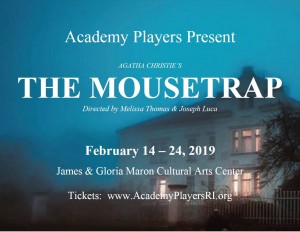 While watching the Academy Players’ current production of Agatha Christie’s The Mousetrap this week, it occurred to me that one of the starkest ironies in pop culture is that the most famous pieces tend to suffer over time from their own success.
While watching the Academy Players’ current production of Agatha Christie’s The Mousetrap this week, it occurred to me that one of the starkest ironies in pop culture is that the most famous pieces tend to suffer over time from their own success.
When a truly groundbreaking play, movie, TV show or even book gets released, it can set the world on fire and might even transform the medium. But over the years, through overt copycatting and subtle homages, the features that made that thing great get filtered into countless other works, so that when new audiences find that original piece years later, it feels dated and trite.
The Mousetrap is a fantastic example. Opening in the West End in London in 1952 and running constantly for the 67 years since (no, that is not a typo), this play helped create the conventions of the murder-mystery genre, including:
- The isolated setting – In order for a story like this to contain the necessary claustrophobia and rising tension it needs, it’s always a good idea for the characters to be stuck together from the beginning to the (often bloody) end. The Mousetrap handles this beautifully through the simple conceit of a blizzard.
- A motley crew of characters/suspects – Eventually, a murder is committed (complete with blackouts and screams). By the time it happens, it helps if the remaining characters are all equally likely to have committed the crime. Christie does a masterful job of this by casting doubt on every person who comes to stay at our inn, as well as the husband and wife proprietors, Giles and Mollie Ralston (Rick Braun and Ryan Foster, respectively). By the time the inevitable crime occurs, the characters are as clueless as the audience as to what happened, and why.
- A stalwart detective to piece it all together – A particular specialty of Christie’s, these stories require a resolution, and what better way than at the hands of an outside detective who arrives on the scene and slowly picks apart inconsistencies and alibis? In The Mousetrap, Detective-Sergeant Trotter (Michael Campbell) arrives at the house (conveniently, on skis) to start stirring up trouble.
- An ending you probably didn’t see coming (unless you did) – Eventually, the events lead to an ending that ties everything together. As audience members, after wondering and speculating for the entire show, you might have figured it out, but more than likely you didn’t have any idea, yet by the time you leave the theater, you’ve convinced yourself that you knew the entire time. The ending of The Mousetrap does exactly this, which I’ll detail at the bottom of the article. *
As you can see, all of these elements seem so familiar that it might feel like you’ve already seen The Mousetrap, even if you haven’t. Luckily, The Academy Players have worked extremely hard to make this production as fresh as they possibly can.
Co-directors Joseph Luca and Melissa Thomas have done an admirable job of moving their large cast in and around the massive stage. Perhaps more impressively, the two also co-designed the set in such a way that, despite the near-constant references to rooms and staircases off-stage, it’s always clear where the characters are at all times. While the show might have been served if they had toned down a few of their actors’ performances (with an audience watching each character so intently for clues, exaggerated guilty looks and/or quirky mannerisms tend to be more distracting than anything else), this is a small nitpick for an otherwise well-conceived and executed effort.
As is the case with shows of this type, it is difficult if not impossible to separate one individual performance from that of the ensemble as a whole. Quite simply, a murder-mystery only really works if everyone does their job as a cohesive unit, working together to take and shift suspicion as the story unfolds. To that end, the cast of this production should be proud of themselves for a job well done. However, having just said (and meant) this, I’d be remiss if I didn’t at least mention Carol Varden as Mrs. Boyle and John Softcheck as Mr. Paravicini for providing very convincing character extremes to balance out everyone else in the middle.
Now, let me briefly mention the real star of the show, which is the show itself. With a story that suffers from its own fame, how does it hold up on its own? If the audience I sat with was any indication, the answer is, very well indeed. People were laughing and gasping throughout the production, and intermission featured a lively discussion over who the murderer might be and why.
If I had any criticism, it would be with two minor decisions made outside of the play itself. First, with a runtime over around 2:30, I would have done what I could (altered blocking or eliminated pauses, when possible) to shorten this where I could. Secondly, I would suggest that the concession stand either switch away from foods with crinkly wrappers, or else include something in their pre-show and pre-intermission announcements about how irritating the sound can be.
But beyond that, for anyone interested in a night of fun (if thematically familiar) whodunit, look no further.
*You can’t possibly have thought I would actually do this.
The Academy Players presents Agatha Christie’s The Mousetrap through Feb 24. 180 Button Hole Dr. (Bldg. 2), Providence, RI 02900. Shows Fridays and Saturdays at 7pm, and Sundays at 4pm. For tickets and more information, visit academyplayersri.org